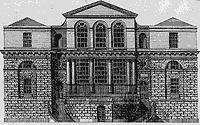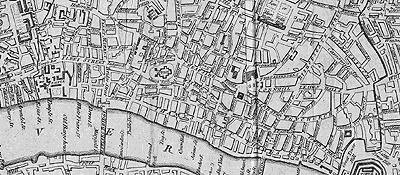|

NOTES ON ISSUE 3: GLOSSARY
PART 2 OF 4
…a patchwork counterpane, like a
Harlequin at home.
A counterpane is “the outer covering of a bed, generally
more or less ornamental, being woven in a raised pattern, quilted,
made of patch-work, etc.; a coverlet, a quilt” (OED). Harlequin – originally a character
in Italian comedy – has become a generic name for a clown
in parti-colored clothes.
...“what are you up to, Aggerawayter?”
Mr. Cruncher’s name for his wife, “Aggerawayter,”
is probably his version of “Aggravator,” since he
believes that her “flopping” – her praying
– has been interfering with his business as an “honest
tradesman.”
… choused this last week into as bad luck as ever a
poor devil of a honest tradesman met with!
To be “choused” is to be duped, tricked, cheated,
or swindled (OED).
“…I am as rickety as a hackney-coach, I’m
as sleepy as laudanum…”
A hackney-coach was a horse-drawn version of the modern taxicab
– “A four-wheeled coach, drawn by two horses, and
seated for six persons, kept for hire” (OED).
Hackney-coaches may – like their modern counterparts –
have varied in condition. The Dictionary of Daily Wants
(1859) gives the following account:
HACKNEY CARRIAGE. – Under this term
are included every carriage, except a stage carriage, ... with
two or more wheels, which is used for the purpose of standing
or plying for hire, at any place within the distance of ten
miles from the General Post Office in the City of London. All
hackney carriages must have four plates, namely, on the back,
each side, and inside, to contain the name and address of the
proprietor…. Any person desirous of obtaining a license
to keep, use, or let to hire a hackney carriage, must apply
in writing to the Commissioners of the Police of the Metropolis,
who, if on inspection, deem the carriage fit, and in proper
condition for public use, shall grant the necessary certificate.
Upon the production of such certificate at the office of Inland
Revenue, a license will be granted. After grant of license,
police may inspect carriages and horses; and if unfit for use,
license may be suspended…. (498-9)
Laudanum, a mixture of alcohol and opium now
recognized as addictive and dangerous, was not only considered
an excellent soporific, but – according to the Dictionary
of Daily Wants (1859) – received its name from its
popular praises:
LAUDANUM. – The word laudanum is derived
from the Latin verb laudare,
to praise, because of its excellent and most laudable qualities
in the amelioration and cure of many diseases in which it had
been employed; it is, perhaps, one of the oldest preparations
in the pharmacy of any nation, and though made of many strengths,
and by different formularies, all have possessed the same general
characters. Though used as a narcotic, antispasmodic, tonic,
stimulant, and anodyne, it is chiefly as a sedative that laudanum
is so invaluable, there being probably no disease, class, or
nature of pain or suffering in which this article has not, or
may not, be employed with more or less of benefit. There is
no drug or compound used in the practice of physic that, properly
employed, is capable of affording so much comfort and relief
to the patient, in almost every disease with which he is affected,
as laudanum, for it may, by skillful combination, and a judicious
adaptation of the dose, be made to exert any special or general
action desired; and since the introduction of a less violent
mode of practice, it has, or may, in conjunction with nitre
and antimony, be depended upon for the cure of nearly every
inflammation that can assail the system, and thus entirely set
aside the use of the lancet in those diseases which were formerly
thought only curable by depletion and bleeding. In repeated
small doses, laudanum acts as a stimulant; in large doses, as
a sedative; and in full doses, as a narcotic; at the same time,
by a modification of the quantity given, it may be made to act
as a tonic in cases of weak digestion, as a diaphoretic in colds
and influenza, and as a diuretic in affections of the kidneys....
Laudanum is a preparation of opium made by macerating a certain
quantity of opium, cut into small pieces, for fourteen days
in a given amount of proof spirits, which is generally equal
parts of spirits of wine, and water, shaking the bottle frequently,
and on the fifteenth day filtering the liquor.
Medical men who prepare their own drugs, and know the advantage
of always having a tincture they can depend on, and of a uniform
strength, simmer their opium in the proper amount of water for
about ten minutes, and to this, when cold, add the spirits of
wine. Unfortunately, the colleges of London, Edinburgh, and
Dublin differ in the strength of this, as of their other preparations,
the consequence of which is, that the dose of laudanum varies
in each country, the dose being in Scotland 21 drops, and in
England 19. (614-5)
…throwing off other sarcastic sparks
from the whirling grindstone of his indignation…
A grindstone – used here metaphorically – is a “disc
of stone of considerable thickness, revolving on an axle, and
used for grinding, sharpening, or polishing” (OED).
He greatly disturbed that poor woman at intervals, by darting
out of his sleeping closet, where he made his toilet…
Young Jerry Cruncher’s “sleeping closet” is
not a closet in the modern sense, but rather a small room “belonging
to or communicating with a larger” one (OED),
in which he has his bed and other personal belongings. As Ian
Watt explains in The Rise of the Novel,
In the medieval period nearly all the life
of the household went on in the common hall. Then gradually
the private bedroom and separate dining quarters for masters
and servants became current; by the eighteenth century [the
period to which the Cruncher household belongs] the final refinements
of domestic privacy had fully established themselves. There
was much more emphasis than before on separate sleeping quarters
for every member of the family, and even for the household servants….
(188)
Private bedrooms were thus, by the end of
the 18th century, a common feature of even humble households
like the Crunchers’; and “closets” –
small private rooms adjoining larger ones – were an economical
way of providing a certain amount of privacy for everyone in
the family.
Jerry’s “toilet” refers
to the process of washing and dressing himself (OED).
(Like the word “closet,” “toilet” in
modern usage has a second, more common meaning. In the sense
used here, the word comes from the French diminutive of the
word for cloth or towel, and is pronounced “twa-lette,”
with the emphasis on the last syllable [OED].)
“… I won’t have my wittles blest off my
table. Keep still!”
“Wittles” is a corruption of “victuals,”
which means food, and is pronounced “vittels” or
“vittles.” According to the OED, “the variant O[ld] F[rench] and
mod[ern] F[rench] form victuaille
has been assimilated to the L[atin] original, and a similar
change in spelling has been made in English, while the pronunciation
still represents the forms vittel,
vittle,” and has been in use since the
fourteenth century.
“You know the Old Bailey well, no doubt?” said
one of the oldest clerks to Jerry the messenger.
The Old Bailey is the street in which Newgate Prison and the
Sessions House stood (it still contains the Central Criminal
Court [Woodley 125]). According to one 19th-century guidebook,
Old Bailey “derives its name from the ballium or open
space in front of the old City Wall, along which it ran from
Lud Gate to New Gate” (Dickens’s Dictionary of
London 199). Lud Gate and New Gate were originally actual
gates to the city; their names are still preserved in the names
of Ludgate and Newgate Streets.
Jerry, sent to the Old Bailey, goes to find Mr. Lorry in the
Sessions House, where trials were held. Harrison’s New
and Universal History and Survey … of London, published
in about 1776, gives the following account of the history, improvement,
and uses of the Sessions House:
[The Sessions House] was formerly a plain
brick edifice, but it has lately [i.e. in the late 18th century]
been rebuilt entirely of stone, and is brought so much forwarder
than the old one as to be parallel with the street. On each
of the sides, is a flight of steps that leads to the court-room,
which has a gallery on each side for the accommodation of spectators.
The prisoners are brought to this court from Newgate [Prison]
by a passage that closely connects between the two buildings;
and there is a convenient place under the Sessions-house in
front, for detaining the prisoners till they are called upon
their trials. There are also rooms for the grand and petty jury,
with other necessary accommodations.
A court is held here eight times a year by the king’s
commission of oyer and terminer, for the trial of prisoners
for crimes committed within the city of London and county of
Middlesex. The judges are, the lord-mayor, the aldermen past
the chair, and the recorder who, on such occasions, are attended
by both the sheriffs, and by one or more of the national judges.
The offences committed in the city are tried by a jury of citizens,
and those committed in the county by a jury formed of the house-keepers
in the county.
The crimes tried in this court are high and petty treason, murder,
felony, forgery, petty larceny, burglary, &c. (473)
This illustration of a “View of [the]
New Sessions House, Old Bailey,” is taken from Thornton’s
New, Complete, and Universal History of … London
(1784). Darnay, accused of treason, is tried in the Sessions
House.

Old Bailey is visible on this portion of Thornton’s
map of London (1784), to the left of St. Paul’s, running
up and down between Ludgate Hill (which begins to the right
of Fleet Street) and Newgate Street (which, north of St. Paul’s,
runs into Cheapside).

Click
on map for larger view
|

